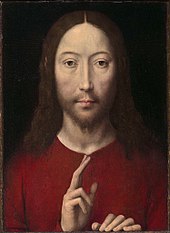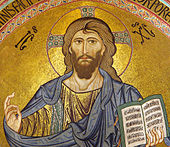Gesture of blessing
|
|
This article was due to acute substance or form defects on the quality assurance side of the portal Christianity entered.
Please help fix the shortcomings in this article and please join the discussion . |


In Christianity, the gesture of blessing is a liturgical gesture for blessing . The blessing is accompanied by the sign of the cross with the hand (hand blessing ) or by the laying on of hands .
Latin Church
In the Latin rite , when the hand is blessed, the thumb, index finger and middle finger are stretched out and point to the Trinity , the other two fingers are bent back and point to the divine and human nature of Jesus Christ . Since Pope Innocent III. (1198–1216) this gesture was prescribed until the liturgical reform. Since then, the priest has been blessing in such a way that all fingers of the right hand are upright. At the final blessing, priests bless with a sign of the cross, bishops with three.
Orthodox Church
In the Orthodox Churches , the thumb and ring finger of the right hand touch each other during the Greek blessing, while the index finger is upright and the middle finger and little finger are slightly curved inwards, so that the letters IC-XC as an abbreviation for the name "Jesus Christ" (Ἰησοῦς Xριστός) to form. The straight index finger results in the I ( iota ), the curved middle finger the C (final sigma ), the folded thumb and ring fingers the X ( Chi ) and the small, in turn curved finger, the second C.
Protestant church
In the Evangelical Church , the raising of the hands at the final blessing of a service is common followed by a sign of the cross (usually in the form of the Latin tradition); in addition, one also knows the blessing by the laying on of hands ( confirmation , marriage , ordination ).